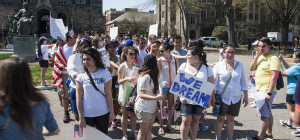
An annual protest for immigrant rights, pictured from 2013, starts on campus, before making its way to the Capitol. The university released updated guidelines for on-campus demonstrations on Monday.
The university released guidelines for campus protests and tabling in an update to the Speech and Expression Policy sent in a campus-wide email yesterday.
The new guidelines for campus protests specify areas of campus in which groups should protest, depending on where an event is held. Students are instructed to protest in the southwest corner of Copley Lawn when events are held in Gaston Hall and in Red Square when events are held in Copley Formal Lounge or the Intercultural Center Auditorium.
These updates were released about two-and-a-half weeks after Hoyas United for Free Speech, a coalition of students advocating for free speech reform on campus, delivered a petition to Vice President for Student Affairs Todd Olson.
The petition garnered about 460 signatures and called for the expansion of free speech zones on campus, the expansion of accessibility for disabled students and the diversification of views presented in class curriculum.
“While HUFS appreciates the changes that the university made in updating the Speech and Expression Policy, we still have several concerns with how the policy now stands,” HUFS founder Vincent DeLaurentis (SFS ’17) wrote in an email.
Specifically, DeLaurentis said that the university should provide training to the university community about the changes to the policy and that the policy must be carried out correctly.
“More so, the release of a new policy does not signal the end of student concern around speech,” DeLaurentis wrote. “HUFS and individual students remain concerned about the protection of free speech and expression on campus and will keep a vigilant eye on university actions related to speech.”
Olson said the updates represent a continuation of ongoing modifications to the Speech and Expression Policy, and minimal substantive change.
“This email was not actually a new policy change — it was the announcement that provided final details on implementation of the changes that we worked through over the past year,” Olson wrote in an email to The Hoya.
The university-wide email from Olson noted that “public squares” where students are allowed to table include Regents Lawn, Library Walk and the Healey Family Student Center. Groups are also now permitted to table in residential areas such as the Alumni Square courtyard and the patio at the base of steps between Henle Village and Darnall Hall, so long as the groups do not become disruptive to residents.
Additionally, Olson’s email stated that the Speech and Expression Committee will issue opinions based on complaints about possible violations of the Speech and Expression Policy so that they can be used as a reference for future complaints.
“I think the most notable change here is that the updates provide greater clarity on key issues of student concern — including expanding tabling locations, policies on student media and a clearer system for students to bring complaints about issues related to speech and expression,” Olson wrote in his email to The Hoya.
Olson’s email included a link to a map that details exactly where groups are allowed to table, which GUSA President Trevor Tezel (SFS ’15) and Vice President Omika Jikaria (SFS ’15) helped to develop. Tezel and Jikaria have worked with the university since the spring to create the map.
“We now have a specific tabling map that we have been pushing for a while, that will lay out clearly to student groups where they can lay out tables and where they can’t,” Tezel said. “We are encouraged by the decision the committee made … and this is now the groundwork for a new culture around speech and expression at Georgetown, though the work is by no means done and we’ll need to stay vigilant.”
H*yas for Choice President Abby Grace (SFS ’16) said that while she is happy with the ways that the policy updates accommodate unrecognized student groups, she would like the university to allow tabling on the sidewalk in front of Healy Hall, among other further measures.
H*yas for Choice was removed from Healy Circle by the Georgetown University Police Department last January when they tabled outside of the Cardinal O’Connor Conference on Life.
While students are allowed to demonstrate in other ways in that area, they are not allowed to place tables in Healy Circle.
“[The university] always uses the justification that you can sit there without the table and it would be just fine, but for us, what’s important is that the tabling is what we do every day,” Grace said. “Most of the time, when we’re trying to make our presence known at these events, we’re trying to make a statement by participating in the same action that we participate in on a daily basis.”




















